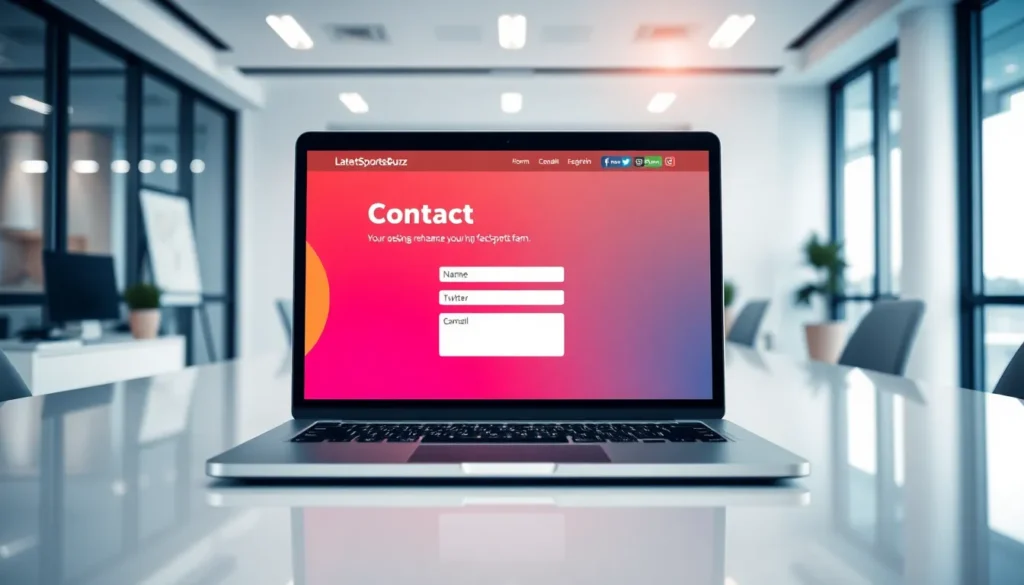Table of Contents
ToggleIn the digital age, your website’s contact page isn’t just a formality: it’s a bridge between potential fans and your brand. Think about it, ever tried reaching out to a company and found yourself lost in cyberspace? Not exactly the best experience. But fear not. Building a contact page that’s navigable, engaging, and responsive can turn those lost souls into loyal followers. Let’s jump into why your contact page is crucial and how to craft it into a must-visit destination for your audience.
Importance Of Having A Contact Page

Every successful website has one thing in common: a well-crafted contact page. This oft-overlooked element can actually make or break your relationship with your users. First and foremost, of course, it establishes credibility. A website without a contact page? It raises a few red flags. Users might think, “If they won’t let me contact them, what are they hiding?”
Also, a contact page simplifies communication. Whether it’s a scent of curiosity or an urgent question, users can easily get in touch. They don’t have to scour through endless pages just for a flicker of hope that someone is monitoring the inbox. This leads to higher engagement rates, which means more loyal followers, and isn’t that what brands are after?
Also, it offers an opportunity for feedback. Any feedback, be it criticism or praise, can help a brand grow. Users love when their voices are heard, and the contact page is their stage to let you know how well (or poorly) you’re performing.
Key Elements Of An Effective Contact Page
Creating an effective contact page doesn’t have to feel like rocket science. Start with these essential elements that will keep users engaged and coming back for more.
Design Best Practices For Contact Pages
A clean, intuitive design is crucial. Think of it as the welcome mat to your brand’s home. Use contrasting colors that make the page easy to navigate and read. UX design isn’t just a buzzword: it’s the key to making your contact page approachable. Simple layouts often outperform elaborate designs because they’re less overwhelming.
Mobile Responsiveness
In today’s mobile-dominated world, a contact page that isn’t mobile-friendly is like a chef who can’t boil water. With more users browsing on their phones, ensuring your page is mobile-responsive guarantees that anyone can reach you, no matter where they are. The buttons should be large enough to click easily, while the form should be simple to fill out on smaller screens.
User-Friendly Forms
Keep forms short and sweet. No one enjoys filling out a novella when they simply want to ask a question. Limit the required fields: ask only for essential information. Think name, email, and message. The easier it is to reach you, the more inquiries you’ll get.
Integrating Social Media Links
Let’s be honest, social media isn’t just a passing trend: it’s transformed how we interact. On a contact page, integrating social media links offers users alternative methods of connecting. This not only enhances user engagement but also presents opportunities for casual interaction. A simple click can redirect them to your Instagram or Twitter profile, where they can comment, like, or even DM you for a quick casual chat.
Having your social media linked can also boost your brand’s visibility. The more platforms you use to communicate, the more your audience feels they can interact with you. Just be sure to keep your social media profiles active: there’s nothing more disappointing than clicking a link only to find a ghost town.
Optimizing Your Contact Page For SEO
Optimization extends beyond the usual SEO tricks, it’s about user engagement and satisfaction. Prioritize making your contact page as informative as possible. Start with an engaging introduction that welcomes users to communicate and reiterates how much their feedback matters. SEO isn’t just about keywords: it’s also about making your page user-friendly.
Maintaining Communication With Users
Once the inquiries start rolling in, maintaining clear communication becomes crucial. This isn’t just about quick responses, but also about providing valuable information. Ideally, every email or message should get a personalized touch. A simple acknowledgment can build trust.
Responding To Inquiries Efficiently
Speed matters. In our fast-paced world, no one wants to wait days for a reply. Establishing a system for managing inquiries can greatly improve this experience. Also, consider creating an email template for frequent questions: this can save time while ensuring users still feel valued.
Encouraging Feedback And Suggestions
A contact page shouldn’t just be a one-way street. Encouraging feedback transforms that static page into a dynamic dialogue. Use call-to-action phrases like “We want to hear from you.” or “Your feedback shapes our future.” Such prompts invite users to share their thoughts and opinions. This not only fosters community but also enhances brand loyalty.
Offering incentives, like featuring selected feedback on your webpage, can also keep users engaged. People love recognition, so showcasing their input can turn casual visitors into loyal advocates. Building a community where suggestions are embraced will make users feel special and valued.







